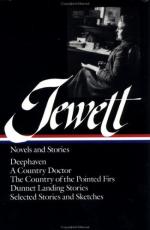|
This section contains 2,981 words (approx. 10 pages at 300 words per page) |

|
SOURCE: “Free Heron or Dead Sparrow: Sylvia's Choice in Sarah Orne Jewett's ‘A White Heron,’” Colby Library Quarterly, Vol. 14, No. 1, March, 1978, pp. 36–41.
In this essay, Brenzo explains the symbolism of Sylvia's climb up the pine tree.
The use of a juvenile narrator or a child's point of view seems especially common in American literature (What Maisie Knew, Huckleberry Finn, “I Want to Know Why”). This technique provides a unique, often humorous view of the foibles of adult society, and, more profoundly, portrays the struggles of the child as he or she grows and tries to form a relationship with that society. In this tradition is one of Sarah Orne Jewett's finest stories, “A White Heron,” a thoughtful portrait of a nine-year-old girl who is suddenly forced to make a very difficult choice between a young man's approval and loyalty to herself and to nature. Because of the striking...
|
This section contains 2,981 words (approx. 10 pages at 300 words per page) |

|


